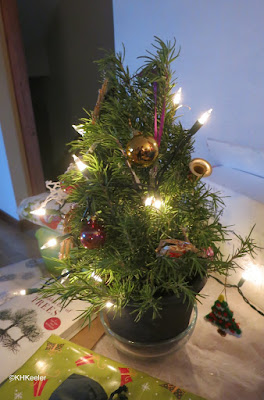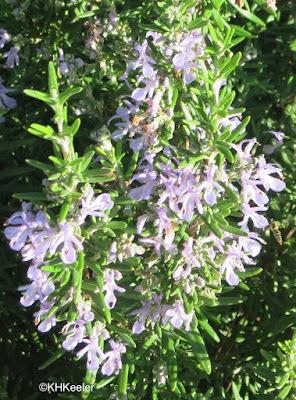 |
| rosemary in flower |
The "Language of Flowers" was a Victorian creation, putting meanings onto plants, so a bud or bouquet could convey a very specific message. There seem to have been several systems, which meant you could misunderstand the message. But, using Kate Greenaway's Language of Flowers, one of the still-available lists (link), a white rose would say "I'm worthy of you, " while receiving white and red roses together meant "unity." In Greenaway's system, rosemary meant "remembrance".
But rosemary's role in remembrance goes back way before the Victorian era (1837-1901). In both ancient Greece and Rome, rosemary was worn by couples at weddings and placed in the hands of the dead. Both of these evoke enduring affection and remembering. Furthermore Greek students reportedly wore rosemary in their hair for examinations, to better remember the information.
 |
| Rosemary in southern Portugal |
 |
| rosemary leaves |
 |
| Rosemary that just barely survived the winter. |
Today rosemary is a spice or an attractive garden plant. Over most of European history, rosemary was more important as medicinal and sacred or magical plant than as a food.
 |
| Two big rosemary plants (and on the right, lavender) |
By the Middle Ages, rosemary was used as a spice as well for diverse household tasks. It flavored meats, sauces and wine. Garlands of rosemary decked the boar's head at the Christmas feast. Rosemary was addded to water for hand washing. Whole or powdered, it was stored with clothes to repel moths.
In addition to these recognizeable uses, rosemary flowers, dried, pulverized, bound in a tightly-woven linen cloth tied to the right arm, made the bearer "light and merry." Similarly, the leaves under the head of the bed prevented evil dreams. Best of all, a box made of rosemary wood, regularly sniffed, preserved one's youth. (Anonymous, 1546)
Rosemary came to be strongly associated with the Virgin Mary, the name transposed to be the "rose of Mary." Native in the Holy Land, rosemary flowers reportedly were white until the Virgin Mary stopped to do laundry during her flight and threw her blue cloak over a rosemary bush to dry. (The other version I saw of the story said she "threw her cloak over the plant," making it sound like she abandoned it. Doing laundry is homey but doesn't discard a good blue cloak.) Likewise, medieval people reported that rosemary never grew taller than the number of years of Jesus's life and after the allotted 33 would spread horizontally rather than growing taller. In medieval lore rosemary grew only in the gardens of the righteous.
With the link to the Virign Mary came a reputation for enhancing fidelity, fertility and happiness in marriage. Many European traditions insisted on establishing that the bride was a virgin, with predictable tensions about best to make this point. One solution was for guests of the bride in English weddings to hold a sprig of rosemary in their right hands and raise them as the bride entered, signalling to all that she was a virgin. As a charm for fertility and happiness, brides often wore or carried rosemary. In 1540 when Henry VIII of England married Anne of Cleves, many, many pots of rosemary were carefully grown in London in order to have ample fresh rosemary for the winter wedding.
Fitting the theme of fidelity, fertility and happiness, in Tudor England, rosemary was considered an aphrodesiac, when either smelled or drunk as distilled rosemary water. Women were advised to carry rosemary, place some in their beds or baths to be "lusty, lively and joyful."
At the same time, rosemary was essential in Christian funerals and burials. Its mystical powers were so strong that they would protect the dead, the living and the church from evil. Rosemary was given to and carried by mourners going to the funeral, who would then place it on the coffin in the grave.
Rosemary's powers comforted the grief-stricken. Sugared rosemary blossoms were often prepared for that purpose.
Just as it protected from evil, rosemary or the scent of rosemary protected people from disease and until quite recently it was widely carried for that reason.
In the late 20th century, when the Oxford Dictionary of Plant Lore authors sought beliefs about rosemary, they were told it was the plant of friendship and that people grew rosemary in the garden so that they would never lack friends.
As a protection from evil and disease, as enhancing friendship and fidelity, and symbolizing remembrance, rosemary has been integral in European culture for at least two thousand years. Today
rosemary is a lovely culinary herb and garden plant, and one of many plants used as a Christmas tree.
 |
| Rosemary plant as a 12" Christmas tree. |
Comments and corrections welcome.
References
Anonymous. 1546. A boke of the propertyes of herbes the whiche is called an herbal. Robert Redman, London.
Culpeper, N. about 1653. Culpeper's complete herbal. online see rosemary
D'Andrea, J. 1989. Ancient herbs. The J. Paul Getty Museum, Malibu, California.
Freeman, M. B. 1943. Herbs for the medieval household, for cooking healing and divers uses. The Metropolitan Museum of Art, New York.
Greenaway, K. 1979. (originally 1884) Language of flowers. Avenel Books, New York. online
PDR for Herbal Medicines. 4th ed. 2007 Thompson Publishing, Montvale, New Jersey.
Rich, V. A. 1998. Cursing the basil and other folklore of the garden. Horsdahl and Schubert, Victoria, British Columbia, Canada.
Vickery, R. 1995. Oxford dictionary of plant lore. Oxford University Press, Oxford.
Kathy Keeler, A Wandering Botanist
More at awanderingbotanist.com


Rosemary Leaves are my go-to herb for making infused oils! I love how it enhances the flavor of olive oil, and it’s perfect for dipping bread. Thanks for sharing such an informative post!
ReplyDelete